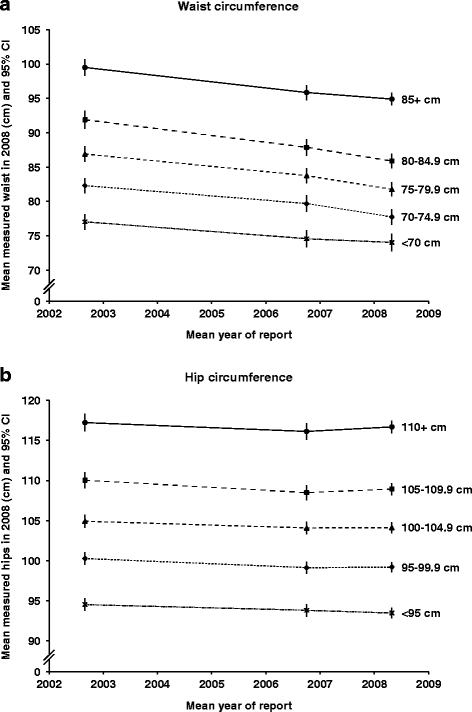Validity over time of self-reported anthropometric variables during follow-up of a large cohort of UK women
- PMID: 26450616
- PMCID: PMC4599695
- DOI: 10.1186/s12874-015-0075-1
Validity over time of self-reported anthropometric variables during follow-up of a large cohort of UK women
Abstract
Background: In prospective epidemiological studies, anthropometry is often self-reported and may be subject to reporting errors. Self-reported anthropometric data are reasonably accurate when compared with measurements made at the same time, but reporting errors and changes over time in anthropometric characteristics could potentially generate time-dependent biases in disease-exposure associations.
Methods: In a sample of about 4000 middle-aged UK women from a large prospective cohort study, we compared repeated self-reports of weight, height, derived body mass index, and waist and hip circumferences, obtained between 1999 and 2008, with clinical measurements taken in 2008. For self-reported and measured values of each variable, mean differences, correlation coefficients, and regression dilution ratios (which measure relative bias in estimates of linear association) were compared over time.
Results: For most variables, the differences between self-reported and measured values were small. On average, reported values tended to be lower than measured values (i.e. under-reported) for all variables except height; under-reporting was greatest for waist circumference. As expected, the greater the elapsed time between self-report and measurement, the larger the mean differences between them (each P < 0.001 for trend), and the weaker their correlations (each P < 0.004 for trend). Regression dilution ratios were in general close to 1.0 and did not vary greatly over time.
Conclusion: Reporting errors in anthropometric variables may result in small biases to estimates of associations with disease outcomes. Weaker correlations between self-reported and measured values would result in some loss of study power over time. Overall, however, our results provide new evidence that self-reported anthropometric variables remain suitable for use in analyses of associations with disease outcomes in cohort studies over at least a decade of follow-up.
Figures


References
-
- Rowland ML. Self-reported weight and height. Am J Clin Nutr. 1990;52(6):1125–33. - PubMed
-
- Stevens J, Keil JE, Waid LR, Gazes PC. Accuracy of current, 4-year, and 28-year self-reported body weight in an elderly population. Am J Epidemiol. 1990;132(6):1156–63. - PubMed
-
- Casey VA, Dwyer JT, Berkey CS, Coleman KA, Gardner J, Valadian I. Long-term memory of body weight and past weight satisfaction: a longitudinal follow-up study. Am J Clin Nutr. 1991;53(6):1493–8. - PubMed
Publication types
MeSH terms
Grants and funding
LinkOut - more resources
Full Text Sources
Other Literature Sources
Research Materials

